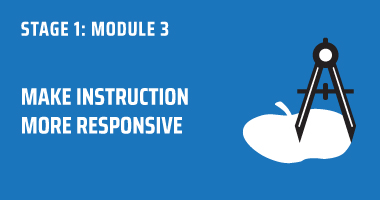Module 3: Make Instruction More Responsive
TIMING: You’ll spend a minimum of 2 weeks in this module after completion of Lesson 1. Watch video to end.
By the End of this Module…
You will make a stronger connection between inequity by design and student learning capacity
You will have a better understanding of what it means to “carry the cognitive load”
You will be able to articulate the fundamental action steps to help students expand their capacity to carry more of the cognitive load during instruction
You will be familiar with the core tools students need to build their learning muscles and the basic coach moves you need to be the “personal trainer” of their cognitive development
You will understand the role student academic mindset plays in cognition and how to help dependent learners make this shift beyond growth mindset cliches
OVERVIEW
How do we get diverse students who have been under-served ready to accelerate their learning? This is what we are all trying to do through culturally responsive practices.
But, too often we think the change needs to first focus on making content more responsive or relevant by diversifying or decolonizing the subject matter content. This is necessary at some point, but insufficient by itself to improve student learning. The idea that the primary way to be culturally responsive is to diversify the content is missing an important point — content is made relevant by the student, not the teacher. And, this idea plays into a key misconception about culturally responsive teaching — it is about improving the student’s self-esteem and motivation, which is built on the faulty narrative of racial difference that says certain racial groups are not motivated toward self-improvement.
Keep in mind that the foundational lever for perpetuating inequitable outcomes at the root of Inequity by Design is the under-development of Black, Brown, and Indigenous students’ cognitive capacity. Therefore, it stands to reason that the way to reverse, interrupt, or subvert this process is to empower diverse students with the ability to accelerate their own learning — as the research calls it “learning how to learn” skills and dispositions.
Remember our core tenet – the student is the unit of change. That statement is going to get clearer and clearer to you as we go into the module’s lessons. In addition, we will touch on the idea of the teacher as “cognitive mediator” or, as I like to call it, the personal trainer of students’ cognitive development.
In Module 2 we focused on deepening our understanding of culture and beginning to make changes in our classroom to balance collectivist and the individualistic practices in ways that created this invisible, non-performative “learning container” for our students as a community of learners to trigger mirror neurons and create a sense of intellectual safety for historically marginalized students.
So we are going to make some assumptions going into this module:
- You’ve done significant relationship building with students and have established learning partnerships or are beginning to do that.
- You have leveled up your relationship work by adjusting opening moves, closing moves, and at least one talk structure in your classroom through the exercises in Module 2
- You have noted a greater sense of intellectual safety among students (i.e., it’s ok to make mistakes and errors are information that can help me improve my learning).
Now in Module 3, we are going to bring the process of expanding the student’s learning capacity front and center in this learning container. We are going to unpack the fundamentals of “getting students ready for rigor.”
While it will feel counterintuitive to focus on helping the student become a better learner as the first step in moving toward cultural responsiveness, I want you to resist the temptation to make this all about making the subject content more diversified or having more social justice themes. It isn’t an either/or choice, but a both/and sequencing issue. We want to help the student to do deep learning when it comes to content, but in order to do that we need to help students build and flex their “learn how to learn” muscles better, especially our dependent learners.
An important note — This is the very unsexy part of becoming a culturally responsive educator. It looks like work. It isn’t readily observable. It doesn’t deal with topics of race, implicit bias, social justice or anti-racism. But, it is THE work if you want to see real change.
So, moving through this module is a great opportunity to check your mindset when frustration surfaces around the exercises and make changes in your practice that might take weeks to put in place, unlike quick strategies or activities to do. Activities don’t make you culturally responsive. Changing students’ brains in ways that upend inequity by design does.
Commit to doing the work. The exercises in this module lay the instructional and inquiry groundwork for Stage 2 inquiry and implementation of the practical elements of the Ready for Rigor Ignite-Chunk-Chew-Review instructional frame.
Save to My Content

